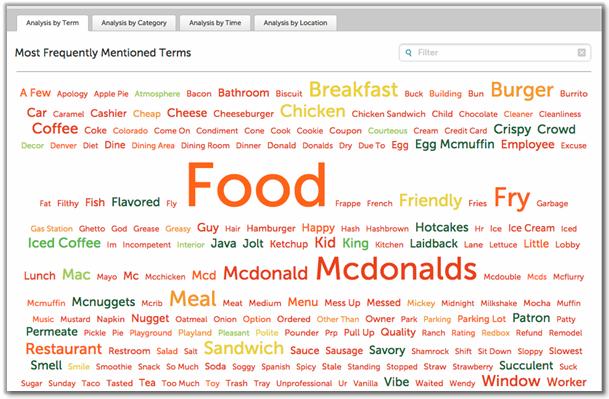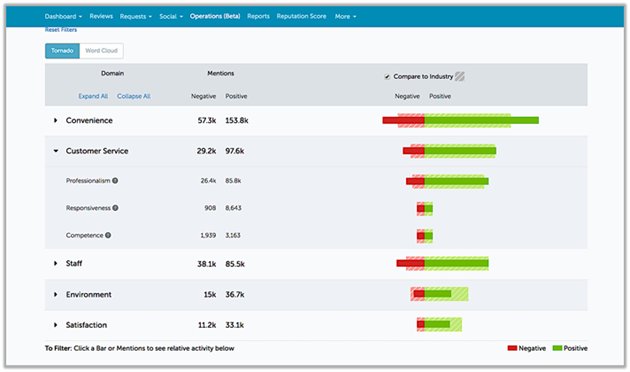Solving the problem of capturing and analyzing "dark data" is the business problem of the century, especially for CMOs who are increasingly accountable for generating revenue and improving business outcomes.
What is dark data? It's the unstructured data that's all over social networks, and it's full of valuable insights you can put to work to generate revenue and improve the way your business operates.
But it's highly likely you're not using it—yet.
According to IDC, 90% of the unstructured data is never analyzed. The practice of online reputation management (ORM) is changing that by helping companies collect and make sense of dark data on social media, to uncover trends and identify strengths and weaknesses in brand perception among target audiences.
In fact, accessing dark data on social media can open up opportunities for improving operations and optimizing customer experience. The challenge is knowing how to mine it and how to put it to work for your organization, by making operational improvements and optimizing the customer experience.
What Is Dark Data—and Why Does It Matter?
Dark data is the unstructured digital information that's lurking in the shadows. But it's not necessarily scary. In fact, it can provide you with early warning into problem areas that need attention.
Gartner describes dark data as "information assets that organizations collect, process and store in the course of their regular business activity, but generally fail to use for other purposes."
On social media, dark data is hidden in plain sight—but it's not being captured or stored by most organizations—and that makes it impossible to analyze and use.
As CMOs become more and more responsible for enabling better business outcomes and increasing market share, tapping into dark data for operational insights will be critical for success. The ability to analyze data and apply learnings to boost demand and generate new revenue will be a key differentiator.
Mining the Value in Unstructured Data
Most of the marketing data we focus on is "structured"—information with a high degree of organization. This type of data resides primarily in relational databases or spreadsheets.
Most structured data comes from form submissions, such as when a website visitor fills out a form to download content from a website. We use that data to inform messaging, segment lists, and create targeted programs.
But only 20% of the data that exists about your organization is structured. The rest—80%—is unstructured. Unstructured data is generated by…
- Customer-call-detail records from call centers or internal customer success teams
- Mobile data about consumer behavior on smartphones
- Marketing automation systems and CRMs, such as Salesforce, which may contain notes from sales reps or marketing team members
- Video and image data, and voice data
Beyond these more obvious sources, real value lies in the unstructured data from new channels—namely, the free-text data found in social posts and conversations, and online reviews on sites like Google, Facebook, and others.
What might happen once we figure out how to harness the volumes of unstructured dark data that exists in the greater cyber universe?
Dark Data's Organic Nature
Most dark data is generated organically. Consumers discuss their purchasing, dining, and entertainment experiences with peers on social networks. They tweet about it, post on Facebook, and share photos and videos. These social shares are shared and shared again, creating a vast amount of content that contains usable feedback and data about public sentiment around your brand.
Imagine a Millennial buys a car at a major auto dealership. She takes a selfie standing by the new car and posts it to Facebook with a caption: "Finally got the new car I wanted, but the salesperson haggled with me for four hours!" Anyone who views her post now has several pieces of information about the dealership:
- It has inventory of a certain type of car.
- It sells cars that may appeal to younger car buyers.
- The staff there isn't in a hurry to sell cars, because they argue with you.
- The buying process at that dealership may take a long time and be stressful.
Now imagine the reviewer's friend comments on the original post and writes, "I bought my car there too, and the finance guy was rude and condescending. He laughed and said I was too young to understand financing." That's more unstructured data that's difficult to capture; when combined with the first post, it points to a recurring theme: Although cars are available and the dealership seems to be frequented by Millennials, the finance department is making it difficult for them to have a good buying experience at that location.
But you can't fix what you know nothing about. If the corporate office guy for that auto company in question could capture the data from both Facebook comments about that particular dealership, he may see a trend—that there's a problem with the finance personnel at that location. But without access to those comments and others like them, he may never know. He may see sales taper off, and assume too much inventory was allocation to the dealership—not that the bad reviews originated from the actions of one employee, and that a more careful screening process for staff hires might result in more sales.
Access to dark data on social media, and linking it to existing CRM data for a composite picture, can help companies refine marketing efforts and initiate operational improvements, which will lead to business efficiencies and a better overall customer experience.
Lighting Up the Dark With Sentiment Analysis
Free text input from social media and online review sources can be filtered using thematic analysis to identify trends in customer sentiment about your business. Serious ORM platforms are able to interface directly with Enterprise-grade CRM platforms, comparing new unstructured data to what you already know about your target customers.
Armed with this information, it's much easier to fine-tune marketing efforts, as well as implement changes in day-to-day operations that could strengthen your reputation.
ORM platforms are enabling unprecedented insight into dark data. For example, we at Reputation.com use word clouds to provide a snapshot of common words and themes that appear in online reviews and social media across the social Web. The larger the word, the more common it is in a company's reviews. Clicking on any word takes you directly to the reviews that contain it:

Taking it a step further, sentiment analysis tools present in-depth analysis of customer feedback and how your locations are performing relative to competitors. Through sentiment analysis, words associated with troublesome keywords are also flagged.
For example, an auto company may be tracking the word "finance" in reviews. An ORM platform using sentiment analysis may also search for words related to finance, such as "pricey" or "interest rate," for a more accurate reflection of the customer experience. With this data handy, the auto company can determine sentiment across multiple or individual locations, for greater operational intelligence.
This tornado chart is one example of such a tool:

Users can click on a keyword, such as "Customer Service" and read individual reviews that mention the word "Customers Service" or other related keywords, such as "Professionalism" or "Competence," for broader context and a more complete picture of the customer experience.
Tools such as these enable companies to harness the value of free-text input, which is often more candid and insightful than structured data from forms and surveys. Think of it as AI for service organizations, where the database is all public sentiment on social media, and the logic detects and surfaces patterns.
ORM technology can also point to next steps for making both granular changes at specific locations, coaching an individual employee, or propagating systematic changes across your organization.
A 360-Degree View of Customer Experience
Data contained in Twitter streams, social media posts, and online reviews can help a company gauge customer sentiment and identify potential problems with service or quality before they affect revenue. When unstructured data is combined with existing data stored in transactional systems, a 360-degree view of their customers' preferences and behaviors emerges.
The result? Happier customers, more positive sentiment, better online reviews and ratings, and—ultimately—more revenue-generating business.




